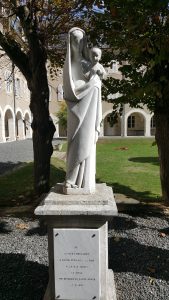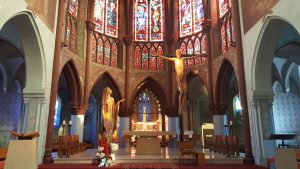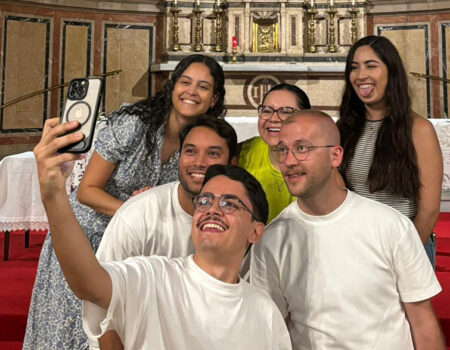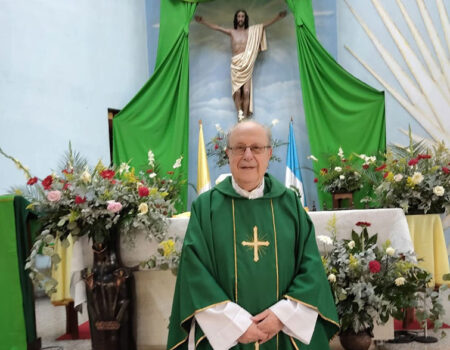OUR LADY OF THE SACRED HEART

First Version of Our Lady of the Sacred Heart at Issoudun, France.
Origins of the Title
Fr. Chevalier’s devotion to Our Lady stands out in his life and his work. His ‘vision’ was that of the Sacred Heart, or Christ in his love, and the world in need. Mary would find her place naturally within this vision; close to the heart of her Son, and able to appeal to him for the world in need. This is well illustrated in Mary’s request to Jesus at the wedding reception in Cana; “they have no wine”. It is easy to see how devotion to Our Lady was principally about her role of mediating the love of God to help humanity, but this was only half the picture in Fr. Chevalier’s mind. She is also firstly, a woman profoundly touched by this very same love revealed through her son, Jesus.
Devotion to Our Lady of the Sacred Heart was established in the context of 19th-century Catholic piety. It was in this perspective that Chevalier’s own spiritual life developed and that his work was done. It was an age of Marian piety. “To Jesus through Mary” was an old Christian adage that had entered into the life of the people. Chevalier recounted, “Shortly after I was baptized, my mother took me to the Church and consecrated me to the Blessed Virgin and to the Sacred Heart of Jesus. Often, especially in later years, she loved to recount this touching scene to which her mind and heart gave a very poetic colouring.” When Jules Chevalier formed his special group in the seminary it was called the association of “the Knights of the Sacred Heart and of Mary.
Later, when at Issoudun he sought a sign that it was God’s will that he should begin his group of missionaries, he and Fr. Maugenest decided to make a Novena to Our Lady. They promised, that should their prayer be heard they would spread devotion to the Heart of Christ and would “make Mary loved and known in a special way, by all possible means”. We have already seen how, on two occasions, just as the two young priests concluded a Novena to Mary, they received two different and generous promises of assistance which made their work possible. It was natural that he should say in later years: “Our Lady has done everything in our Congregation”. It was natural, too, that against the general background of the times and with his own particular experiences, he should look to Mary for continued help in his work of bringing the love of the Heart of Christ to people and of bringing people to believe in and respond to that love. A further natural development was that he and his companions should begin to think and speak of Mary as “Our Lady of the Sacred Heart”.
Once during the summer of 1857, while he was relaxing with his fellow MSC, they were discussing plans and ideas for the new church they were building. Fr. Chevalier asked what were their thoughts about the title under which Mary should be honoured in the new church. Various suggestions

2nd. version of Our Lady of the Sacred Heart at Issoudun, France.
were made – but of course he was leading up to the proposal he had had in mind for some time: that of honouring Mary under the title of Our Lady of the Sacred Heart.
What this title expresses
In explaining what he meant Chevalier said that the title Our Lady of the Sacred Heart indicates her who was blessed among all women by the heart of a loving God. At the same time, it points to her as the Mother of humanity whose only desire is to lead all people to the heart of her Son. Finally, this name makes us understand that our heavenly Mother is forever our powerful advocate with the Heart of her loving Son.
At the beginning of 1861, when preparations were being made for the inauguration of the first part of the church, Fr. Chevalier wanted it to include a stained-glass window of Our Lady of the Sacred Heart. The image was of Mary Immaculate, standing with her hands extended towards the earth. In front is the Christ child, indicating his heart with his left hand and pointing to his Mother with his right – as if to say: “Through my Mother the riches of my heart may be known on earth”. Later the image of Mary was changed; Mary standing, holding her Son Jesus in her arms and reaching to touch his Heart.
In each culture, this image is expressed in its own way, safeguarding the essence of what the title of Our Lady of the Sacred Heart implies; the ability of a Mary to appeal deeply to the sentiments in the heart of her Son, calling forth the abundance of goodness and love that is there for all humanity. A love that is full of tenderness, kindness, and compassion. This is what makes Mary the most powerful intercessor, and why she is often referred to as the “Advocate of difficult and desperate causes”.

3rd. version of Our Lady of the Sacred Heart at Issoudun, France.





